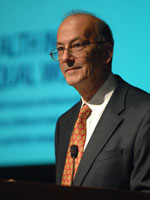A Russian spring for research
May / June 2011 | Volume 10, Issue 3

Dr. Roger I. Glass,
Director of the Fogarty
International Center
Opinion by Dr. Roger I. Glass
Director, Fogarty International Center
In 1971, when I was at the Harvard School of Public Health completing my M.P.H., Dave Rall, the director of the National Institute of Environmental Health Sciences, asked me to help out on a project that resulted from an agreement between President Richard Nixon and then-Soviet leader Leonid Brezhnev. Rall had heard I’d taken Russian in college, though I was far from fluent. Still, when the opportunity arose for a seven-month stint in the U.S.S.R., I readily agreed and traveled to Moscow to work at the Sysin Institute of General and Municipal Hygiene, researching standards for environmental pollutants, while residing in a classic Soviet building called the Hotel Peking.
It was a fascinating time: it was the middle of the Cold War with very few Americans in the country. The atmosphere for collaboration was not good, but I met some wonderful people.
During my latest visit in April, I took note that the Hotel Peking is still there, but much is changed. Moscow is really a beautiful, developed and exciting city. The Russian Academy of Sciences has a brand new building that’s state of the art. The renovation of all the little churches around the city is striking and those onion-shaped domes add a unique quality. Even Domodedovo airport has been made new again.
The other thing that’s new is the spirit of cooperation and collaboration. Twenty years after perestroika, Russia is now investing anew in research. The difficulties with the economic transition after the Soviet Union was dissolved caused many scientists to leave and many of their institutions were decimated. Now they’re beginning again to invest in research and training in a big way, so it provides an opportune moment to rekindle relations and take advantage of their scientific brainpower to work in collaboration with the Russians.
At the meeting to plan the U.S.-Russia Forum for Biomedical Research (see related article, Moscow talks further US-Russia scientific collaboration), we were hosted by the Russian Academy of Sciences, with the Minister of Health and the head of the Academy of Medical Sciences joining in to try to encourage these three independent agencies to work together to promote scientific collaboration. And this was aided by the Foundation for NIH, which brought together a tremendous group of private companies, which all have an active interest in promoting research in their specific fields. So we had a day of meetings to organize the Forum and then a day of visits to different Russian institutions that may serve as partners for future collaboration.
We also attended the meeting hosted by WHO on noncommunicable diseases and healthy lifestyles. Both the U.S. and Russia share huge problems with NCDs, with smoking, obesity, addiction and alcohol as well as problems with multiple drug resistant TB. This presents other opportunities for working together. Russia has done some interesting work on new drugs and stem cell research and they’re trying to begin a major initiative for drug discovery and development. So it’s really an excellent time to explore new avenues of cooperation.
And Russia is no longer a ‘recipient’ country; they see themselves as donors. Thus, they will fund their part of the research that we do together. Their goal is collaboration, not financial support.
After the group led by Drs. Bernard Lown and Yevgeny Chazov won the Nobel Peace Prize in 1985, there was joint research in the field of cardiovascular disease with the U.S. But that hasn’t been so in other fields and I think that’s going to change.
Like those rejuvenated onion domes popping up all over Moscow, the landscape of scientific collaboration between the U.S. and Russia is undergoing its own perestroika.
More Information
To view Adobe PDF files,
download current, free accessible plug-ins from Adobe's website.